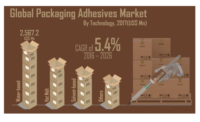The global flexible packaging market is projected to expand at a CAGR slightly over 5% during the forecast period (2016-2024) due to various factors, as revealed in Transparency Market Research's (TMR) lastest report, Flexible Packaging Market - Global Industry Analysis, Size, Share, Growth, Trends and Forecast 2016 - 2024.
Flexible packaging provides all the properties needed for primary as well as secondary packaging such as lightweight, high performance, high barrier and low contamination, and keeps the product completely sealed off from the environment. Flexible packaging products uses more than 70% less plastics than rigid packaging options and also consumes smaller space during packaging and on shelves in retail outlets. Flexible packaging also offers a number of sustainability advantages including low raw material consumption, low carbon footprint, reduced energy usage, and relatively low waste produced as compared to conventional packaging formats and hence, are more preferred. These sustainability advantages offered by flexible packaging are expected to drive its demand over the forecast period. As competition intensifies in consumer products market, product manufacturers and brand owners are identifying as well as capitalize the latent potential in the market.
Changing consumer lifestyle has increased dependence on processed, pre-cooked and packed foods, which also mobilized the entire flexible packaging supply chain to sync product offering as per end customer's requirement. On similar lines, the industry also witnessed introduction of new and efficient films that are used in flexible packaging. Modified Atmosphere Packaging (MAP), vacuum skin packaging are some of the current trending packaging solutions which have been developed to meet end customer demand.
The global flexible packaging market is segmented on the basis of material type, product type and application. On the basis of material type, the global flexible packaging market is segmented into polymer, paper, aluminum and cellulose. Polymer material is further sub-segmented into polyethylene, polypropylene, biaxially-oriented polypropylene (BOPP), cast polypropylene, biaxially-oriented polypropylene terephthalate (BOPET), ethylene vinyl alcohol (EVOH), polyamide, polyvinyl chloride, polystyrene. On the basis of product type, the global flexible packaging market is segmented into stand-up pouches, vacuum pouches, retort pouches, gusseted bags, wicketed bags, converted roll stock, squeezable bottles and others. Among products, vacuum pouches and retort pouches are projected to be the most attractive segment over the forecast period.
On the basis of application, the global flexible packaging market is segmented into consumer product applications and industrial & institutional product application. Regionally, the global flexible packaging market is segmented into North America, Latin America, Europe, Asia Pacific (APAC) and Middle East and Africa (MEA).
Among materials, polymer segment accounts for a major share in the global market. However, BOPP, BOPET and EVOH sub-segment in the polymer segment is expected to expand at highest CAGR in terms of value over the forecast period. Leading players in flexible packaging market are shifting their focus from conventional plastic packaging to sustainable packaging solutions due to the stringent environmental regulations, aimed to limit carbon footprint. Asia Pacific is anticipated to grow at a CAGR of over 8% in terms of value over the forecast period.
In 2015, the consumer product application segment accounted for the 80% market value share. Majority of the industries engaged in consumer products manufacturing, such as food & beverage, pharmaceutical, cosmetic and other consumer product are much focused towards offering products with improved extended shelf life. Properties offered by flexible packaging, identified as a crucial parameter which influences consumer's buying behaviour, hence, are more preferred by brand owners and manufacturers. Increasing disposable income in developed and developing countries is another factor driving consumer spending on high end premium goods viz. a viz. flexible packaging market.
